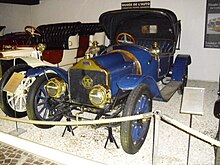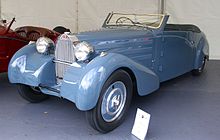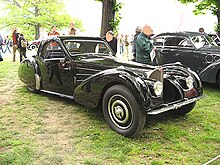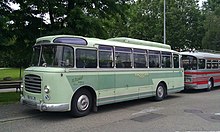Gangloff body shop (Colmar)
| Gangloff body shop
|
|
|---|---|
| legal form | Corporation |
| founding | circa 1927 |
| Seat | Colmar ( Alsace , France ) |
| management | Gottlieb Moor, Paul Horlacher |
| Branch | Body shop |
Carrosserie Gangloff in Colmar ( Alsace , France ) is a former Swiss- French company that manufactures special bodies for luxury cars. It was founded as a largely independent subsidiary of the Carrosserie Georges Gangloff with headquarters in Geneva and later in Bern , and was then bought by two operations managers and continued independently. With the decline of French luxury cars, and especially Bugatti, after 1945, the market for Gangloff collapsed. The company then built bus bodies for a short time before operations ceased. The head office in Switzerland is now a body repair company with a paint shop and manufactures cable car cabins, railway rolling stock and trailers for commercial vehicles.
Company history

Carrosserie Georges Gangloff emerged in 1903 from the carriage building company founded in 1878 by the brothers Georges and John Gangloff in Geneva . The brothers separated, Georges continued to run the company alone as Georges Gangloff SA and soon moved into larger premises in the Sécheron district in Geneva . Johns J. Gangloff & Cie. in Lausanne was taken over by a competitor in 1912 and disappeared.
Operations in Colmar began in 1919 with the aim of operating closer to the French market for special bodies, which is important for the company, while at the same time avoiding the high import duties to France. Georges Gangloff did well with French customers who appreciated his skiffs on pic-pic chassis. Initially, the coachbuilder Wiederkehr rented premises on Rue Stanislas ; This was followed by a stake in this traditional carriage and body shop and, in 1930, as part of a succession plan, the entire takeover. The parent company, now headquartered in Bern, sent two employees who had been working for the company since 1927, Gottlieb Moor and Paul Horlacher , who ran the company as largely independent co-managing directors.
In 1936 the parent company in Switzerland went bankrupt due to adverse circumstances and the poor economic situation . While a part in Geneva was taken over by senior employees and continued as Carrosserie de Sécheron , all of the remaining branches had to be sold. The Zurich headquarters (formerly Carrosserie C. & R. Geissberger ) went to Carrosserie Langenthal AG in Langenthal ( Canton of Bern ). From the former headquarters in Bern, Dr. R. von Muralt led Neue Carrosserie Gangloff AG , which specialized in the manufacture of cable car cabins and rolling stock for narrow-gauge railways and which became a well-known supplier of bus bodies.
In Colmar, Moor and Horlacher were able to take over the business with the help of master saddler Dürr . It is conceivable that they were also supported by the Bugatti family; the order volume from Molsheim then increased significantly.
Innovations
In the late 1910s, Georges Gangloff developed a hinge system that allowed slimmer roof pillars on four-door cars. This system was also used at Gangloff in Colmar and licensed to other coachbuilders. The American designer Frank Spring (1893–1959) got to know it in Europe and brought it to the USA. When he became chief designer at the renowned coachbuilder Walter M. Murphy Company in Pasadena (California) , his employer acquired a license and developed it further into the Clear vision system. It was - somewhat exaggerated - claims that a Clear Vision - A-pillar as the distance between the eyes of the driver is narrower from each other and therefore that not the column is perceived. But it was undoubtedly a step forward compared to the usually massive pillars and also allowed a more elegant design with a lighter-looking roof.
Close connection to Bugatti
Moor and Horlacher knew how to make very good contacts with Bugatti in Molsheim (Alsace), only 55 km away . A friendly relationship developed with the patron Ettore Bugatti and his son and chief designer Jean . This, and above all the high quality, meant that on the one hand Gangloff became by far the largest bodywork supplier for Bugatti and, on the other hand, this company was also clearly Gangloff's most important customer. At the best of times, five bodies were made every month for this brand alone.
Bugatti has maintained since 1923 resp. In 1927 or 1928 it had its own body department, but this was chronically busy. The delivery of the bare chassis to Colmar took place on its own axis (with primitive seating) by Bugatti employees, among them the Grand Prix - racing driver René Dreyfus , who considered these overpasses as driver training. The drafts for the "factory bodies" from Bugatti (those versions that were listed in the sales catalog) came from Jean Bugatti and, with a few exceptions, were similarly produced in the in-house body shop.
Gangloff had his own drawing office, which was last headed by Lucien Schlatter (1920-?). He started at Gangloff as a draftsman and designer apprentice at the age of 14 and stayed with the company until his retirement.
Despite the close and friendly ties to Bugatti, Gangloff also built other chassis. However, there were not many of them because the orders from Molsheim left little capacity for them. This also resulted in the company becoming dependent on Bugatti. However, it is not known that this would have put pressure on Gangloff. On the other hand, because Gangloff's connection to Bugatti was of course known, there were only occasional inquiries from other automakers for exhibition and demonstration vehicles. A Mathis Emyhuit Type FOHL eight-cylinder is known, which received a convertible body from Gangloff in 1933.
Type 30
The Bugatti Type 30 is the ancestor of the sporty inline eight-cylinder models. Gangloff bodyworked at least one Type 30, a short, two-seater convertible with an inclined, fixed windscreen and indicated stubby rear. The vehicle is preserved.
Type 49
The Type 49 was the last development stage in the series that began with the Type 30. It had a 3257 cm³ in-line eight-cylinder engine, which consisted of two blocks with 4 cylinders each, an overhead camshaft, vertical shaft drive and it was also available with a compressor. Gangloff designed such a version as a more elegant than sporty convertible.
Type 50
The Bugatti Type 50 with chassis number 50139 received a convertible body from Gangloff in 1932. The two-seater with a “mother-in-law seat” has a few detailed solutions (such as the slightly tapering rear) that are reminiscent of the first Type 41 (the “Esders Roadster”). That may, but does not have to, indicate that this Gangloff body was drawn by Jean Bugatti.
Type 55
The Bugatti Type 55 was largely created under the responsibility of Jean Bugatti, who had also designed gorgeous bodies for it. This included a roadster with or without doors and three slightly different, two-seater coupés. One of them was designed as a faux convertible with a leather bow on the roof and storm bars. Gangloff contributed his own interpretations of the given design theme.
Like all Bugatti, the Type 55 was also available as a "rolling chassis", that is, with a ready-to-drive chassis with drive and radiator. Gangloff dressed at least one roadster according to their own design.
Type 57
The Bugatti Type 57 was the longest built and most successful model of the brand. It was also offered with a series of “factory bodies” based on designs by Jean Bugatti, which were given separate model names, mostly from Alpine passes .
When the number of units rose sharply after the introduction of the Type 57 , Gangloff also received orders to build such bodies. At the Bugatti stand at the 1936 Paris Motor Show alone, two of the four exhibits were bodyworked by Gangloff. On the part of Bugatti, the trust in Gangloff was ultimately so great that it was decided not to send Gangloff the construction plans. So it happens that the Gangloff creations follow the lines given by Jean Bugatti, but are independent creations with different detailed solutions. The quality of the execution met the highest standards both in the factory and at Gangloff. A few closed specimens received the "Vutotal" front panel developed by Labourdette with an extremely thin frame.
From the 680 to 710 resp. 830 Type 57s were built, around 180 were bodied at Gangloff, significantly more than any other bodybuilder with the exception of the factory itself.
Cabriolet Stelvio
With the introduction of the Type 57, Jean Bugatti gave his creations additional names in the catalog, mostly from mountain passes associated with mountain races and similar sporting events: Stelvio , Galibier , Ventoux , Atalante , Aravis and Atlantic . Most of them also had a variant of Gangloff. No bodies at all were manufactured in Molsheim for the two-seater Stelvio convertible . Most of them were made at Gangloff in Colmar and a few at other coachbuilders . Stelvio is the Italian name for the Stilfser Joch .
But there were also Gangloff versions of the other “factory bodies” Galibier , Ventoux , Atalante and Aravis ; however, the company was not involved in any of the four Atlantic super sports cars built .
Berline de Sport Galibier
Galibier was the name for a four-door sports sedan without a B-pillar and with portal doors without handles on the rear doors. On this design by Jean Bugatti, the rear doors could only be opened when the front doors were already open. The first of the three series was a bit filigree. Gangloff showed a Galibier on the Bugatti stand at the Paris Motor Show in February 1936 .
The Galibier was the only four-door in the Bugatti catalog.
Coach Ventoux
The Ventoux was the most popular version of the Type 57. It was a two-door, four-seater version, which was then known as the Coach . Today it corresponds to a two-door sedan.
The name goes back to the Mont Ventoux in Provence , where bicycle and automobile hill climbs were held. The lines in the 1st series are strongly influenced by the Type 50 Coach profilé with a slightly less flat windshield. The Ventoux was available with or without a side window in the C-pillar . Many customers underlined the rather heavy-looking body for a Bugatti with cladding on the rear fenders.
Atalante coupe
The Atalante was a 2-seater, very sporty coupé that was offered from 1935 to 1938 (Type 57 Series 1 and 2). Atalante is a character from Greek mythology . A fabric sliding roof was available on request, which could be opened with a hand crank and was guided in rails. It also included the roof end including the rear window.
Gangloff has bodyworked several Atalante , including a black one on the S-chassis (chassis no. 57532).
Cabriolet Aravis
With the Series 3 (from 1938) the Aravis Cabriolet replaced the Atalante and at the same time offered a sportier alternative to the Stelvio , which was intended more for longer tours. Gangloff built at least one coupé version in 1939 (chassis no. 57710).
According to one source, the Aravis was only offered in 1939.
The name goes back to a mountain range in the French pre-Alps ( Savoy and Haute-Savoie ).
Unique pieces and own creations
Gangloff designed the Type 57 "Grand Raid" as early as 1934, a breathtaking sports car as a roadster and coupé. These attractive sports versions were offered to Bugatti as factory bodies. Jean Bugatti gave preference to his own design, Aérolithe , which was included in the range as the Type 57SC Atlantic and only as a coupé. Of the 10 or so “Grand Raids” built, one may have survived. There is also a detailed replica. From the Atlantic only four copies were selling.
An extraordinarily elegant and at the same time very sporty coupe based on the Aravis did not fare any better the following year; This was also waived in Molsheim in favor of the Atlantic.
For a customer who wanted an alternative from Bugatti to the sweeping creations that Figoni & Falaschi or Saoutchik implemented mainly on Delahaye and Delage chassis, Gangloff created a single, very extravagant convertible with a fixed windshield and lavish ornamentation. Despite the lush shapes, it was possible to make this Type 57C appear sporty, typically Bugatti.
With the Cabriolet profilée , Gangloff created a sporty and elegant reinterpretation of the Grand Raid on the new SC chassis in 1937 .
Type 64
The Type 64 was designed as a prototype for a successor to the Type 57. The construction came about under the supervision of Jean Bugatti, who probably also contributed the design draft. The vehicle has a completely new chassis, in which two U-shaped profiles made of particularly tensile duralumin were riveted together to form longitudinal members for the box frame . These girders were also cranked several times: at the front and back to accommodate the axles and in the center to the outside to gain more space for the passengers. In addition, following current trends from the USA , the engine was moved further forward.
Gangloff's structure is elongated and elegant. He can be described as a coach with a hatchback for four people. The front was developed around the radiator of a Type 57 S. When it was moved forward, the chrome headlights found a position between the bonnet and the teardrop-shaped "pontoon" fenders. The line is based on the theme that Jean Bugatti had specified with the Type 57 variants Aérolithe and Atlantic in a more radical direction. Its characteristic feature, a sheet metal seam riveted lengthways across the body, is hinted at on the Type 64 in the sheet metal. The two fully wired spare wheels embedded in the front fenders are unusual for a Bugatti. The rear fenders have fashionable cladding.
The development of the Type 64 was not continued after Jean Bugatti's death in August 1939. The vehicle remained in the company's possession and probably came into the possession of the brothers Hans (1904–1989) and Fritz Schlumpf (1906–1992) in 1964 with the sale of the plant and its inventory and then to the collection of the Cité de l'Automobile in Mulhouse .
As contemporary photos show, this Gangloff Coupé was originally painted in light colors. Today it is presented in black with the same spoke wheels. It was probably given this coloring in the factory in Molsheim. In 2009, the only Type 64 built was restored to the point that it can occasionally be driven. A complete restoration is not planned.
Type 101
The Type 101 was the last Bugatti to hit the road. Technically, it largely corresponded to the Type 57 and was an emergency solution because the funds were not available for a planned new design.
After Ettore Bugatti's death in 1947, the company suffered from unclear ownership. In the end, only six were built. After all, two of them, the vehicles with the chassis numbers 101.501 and 101.503, received almost identical convertible bodies from Colmar. Gangloff designed it in 1951 in the fashionable pontoon style , i.e. without detached fenders and with integrated headlights. A very similar coupé body was created in 1952 on the chassis of a Type 57 (No. 57454).
An illustration of a Gangloff convertible graced the title page of the Type 101 brochure.
Superstructures for buses
After the Second World War , the demand for special bodies fell sharply in general. Most manufacturers of such chassis adapted to the circumstances and brought out cheaper models. Many also had to give up completely. Technically, the introduction of the self-supporting body brought great progress both in terms of quality and manufacturing costs, so that from this point of view, one-offs no longer made sense. In France, developments accelerated when the de Gaulle government imposed high luxury taxes on cars. This accelerated the decline of the traditional French Grandes Routières . Bugatti was just one of the manufacturers affected; others were Delage , Delahaye Talbot-Lago (actually an unofficial name), Hotchkiss or Salmson . Panhard & Levassor had shown foresight and immediately after the war made an initially successful conversion to small and innovative passenger cars.
The aforementioned dependency on Bugatti orders has probably accelerated the end of car body construction at Gangloff in Colmar. Like the parent company in Switzerland, Gangloff also tried to diversify into the commercial vehicle sector in Colmar. For Berliet , a number of bus bodies were created on the PLB 8 chassis .
The Colmar company seems to have existed for many years after giving up the body shop. In Switzerland, the car body construction at Gangloff ended with the collapse of Georges Gangloff SA . The branch in Bern was sold and specialized as Neue Carrosserie Gangloff AG in cabins for cable cars and narrow-gauge rolling stock; As Gangloff Trailers , after a restructuring of Gangloff AG, the company is now their mainstay for commercial vehicle bodies and truck trailers.
literature
- Hugh G. Conway: Les Grandes Marques: Bugatti. Gründ, Paris 1984, ISBN 2-7000-5175-8 . (French)
- GN Georgano (Ed.): Complete Encyclopedia of Motorcars, 1885 to the Present. 2nd Edition. Dutton Press, New York 1973, ISBN 0-525-08351-0 . (English)
- Serge Bellu: La Carrosserie Française: you style au design. ETAI Publishing House (Editions Techniques pour l'Automobile et l'Industrie), 2007, ISBN 978-2-7268-8716-5 . (French)
- Serge Bellu: La carrosserie: Une histoire de style. Editions de la Martinière, 2010, ISBN 978-2-7324-4128-3 . (French)
- Ferdinand Hediger: Swiss Carrossiers 1890–1970. 1st edition. SwissSlassics Publishing AG, Bäch SZ (Switzerland) 2013, ISBN 978-3-9524171-0-2 .
- Joachim Kurz: Bugatti. The Myth - The Family - The Company. Econ-Verlag (Ullstein book publishers), Berlin, ISBN 3-430-15809-5 .
- Wolfgang Schmarbeck, Gabriele Wolbold: Bugatti passenger and racing cars since 1909 (type compass series). 1st edition. Motorbuchverlag, Stuttgart 2009, ISBN 978-3-613-03021-3 .
- Hugh G. Conway: Les Grandes Marques: Bugatti. Gründ, Paris 1984, ISBN 2-7000-5175-8 . (French)
- Hugh G. Conway: Bugatti. (Big brands). Heel, Königswinter 1984, ISBN 3-8112-0846-2 .
- George Hildebrand (Ed.): The Golden Age of the Luxury Car - An Anthology of Articles and Photographs from Autobody. 1927-1931. Dover Publications, 1980, ISBN 0-486-23984-5 . (English)
- Henry Rasmussen: The Survivors. (The Survivor Series). Picturama Publishing, 1975, ISBN 0-918506-01-8 . (English) (Portrait of a Bugatti Type 57S Coupé Atalante Gangloff (1937))
Web links
- Homepage of Gangloff AG Bern (accessed on February 4, 2013)
- coachbuild.com: Carosseries Gangloff (accessed October 1, 2014)
- conceptcarz.com: Some Gangloff bodies (1927–1939) (English) (accessed October 1, 2014)
- swisscarregister.ch: Georges Gangloff (accessed on November 15, 2016)
- swisscarregister.ch: John Gangloff (accessed November 15, 2016)
- swisscarregister.ch: C. & R. Geissberger (accessed on November 15, 2016)
- coachbuilt.com: Walter M. Murphy Co. (accessed February 4, 2013)
- coachbuilt.com: Larkins & Co. (accessed February 4, 2013)
- coachbuilt.com: Designer Frank Spring (accessed February 4, 2013)
- Francois Vanaret: Carosseries Gangloff (French) (accessed October 1, 2014)
- GTÜ-Oldtimerservice: Gangloff Colmar (accessed on November 20, 2013)
Bugatti
- conceptcarz.com: Bugatti Type 46S (accessed February 6, 2013)
- conceptcarz.com: Bugatti Type 50 Gangloff (English) (accessed October 1, 2014)
- conceptcarz.com: Bugatti Type 57S (accessed October 6, 2014)
- ritzsite.nl: Bugatti Type 57: The crown on the myth (accessed July 29, 2013)
- ritzsite.nl: Bugatti Type 57 Atalante (accessed July 29, 2013)
- ritzsite.nl: Bugatti Type 57 Atlantic (accessed July 29, 2013)
- ritzsite.nl: Bugatti Type 57 Galibier (accessed July 29, 2013)
- ritzsite.nl: Bugatti Type 57 Stelvio (accessed July 29, 2013)
- ritzsite.nl: Bugatti Type 57 Ventoux (accessed July 29, 2013)
- ritzsite.nl: Bugatti Type 57 Aravis (accessed September 13, 2013)
- ritzsite.nl: Bugatti Type 57 Specials (accessed July 29, 2013)
- ritzsite.nl: Car of the Month, October 2005. Bugatti Type 57C Roadster (Gangloff) (English) (accessed February 5, 2013)
- Bonhams auctions: Paris Expo, Porte de Versailles Automobiles d'Exception , February 9, 2008: lot no. 168; Bugatti Type 57 Coach Gangloff, Chassis No. 57546 (English) (accessed February 4, 2013)
- artcurial.com: Salon Rétromobile, Paris 2013; Lot 364: Bugatti Type 57C Ventoux # 57452/57308 (1936) (French / English) (accessed October 14, 2014)
- supercars.net: Bugatti Type 57S (1935) (English) (accessed September 14, 2013)
- conceptcarz.com: Bugatti Type 57S Stelvio, Chassis No. 57396 (1937) (English) (accessed April 24, 2013)
- conceptcarz.com: Bugatti Type 57 Aravis Coupé Gangloff, Chassis No. 57710 (1939) (English) (accessed April 25, 2013)
- ultimatecarpage.com: No. 3967 / Bugatti Type 57 SC Coupe Atalante Gangloff, Chassis No. 57532 (1937) (English) (accessed September 25, 2014)
Individual evidence
- ↑ a b Hediger: Schweizer Carrossiers 1890–1970 (2013), p. 42.
- ↑ coachbuilt.com: Walter M. Murphy Co.
- ↑ coachbuilt.com: Larkins & Co.
- ↑ coachbuilt.com: Frank Spring (1893–1959)
- ↑ a b c d e f Bonhams auctions: Paris Expo 2008 ; Lot 168; Bugatti T57 Coach Gangloff # 57546
- ↑ In short: Bugatti. The Myth - The Family - The Company. P. 143.
- ↑ a b conceptcarz.com: Bugatti Type 46S.
- ↑ François Vanaret: L'Âge d'or de la carrosserie française; Carrosseries Gangloff.
- ↑ a b coachbuild.com: Gangloff
- ↑ conceptcarz.com: Bugatti Type 50 Gangloff
- ↑ Bellu: La Carrosserie Française: du Style au Design (2007), p. 154.
- ↑ ritzsite.nl: Bugatti Type 57: The crown on the myth
- ↑ a b artcurial.com: Salon Rétromobile, Paris 2013 ; Lot 364: Bugatti Type 57C Ventoux # 57452/57308 (1936)
- ↑ Estimate in the German language Wikipedia without reference to the source
- ^ Conway: Les Grandes Marques: Bugatti (1984), p. 77 '
- ↑ supercars.net: Bugatti Type 57S (1935)
- ↑ ritzsite.nl: Bugatti Type 57 Stelvio
- ↑ a b ritzsite.nl: Bugatti Type 57 Atlantic
- ↑ ritzsite.nl: Bugatti Type 57 Galibier
- ↑ ritzsite.nl: Bugatti Type 57 Ventoux
- ↑ ritzsite.nl: Bugatti Type 57 Atalante
- ↑ conceptcarz.com: Bugatti Type 57S
- ↑ conceptcarz.com: Bugatti Type 57C Aravis Coupé Gangloff, chassis no.57710 (1939)
- ↑ ritzsite.nl: Bugatti Type 57 Aravis
- ↑ ritzsite.nl: Bugatti Type 57 Aravis
- ↑ ritzsite.nl: Bugatti Type 57 Specials
- ↑ ritzsite.nl: Car of the Month, October 2005. Bugatti Type 57C Roadster (Gangloff)
- ↑ Schmarbeck / Wolbold: Bugatti passenger and racing cars since 1909 ; Typenkompass (2009), p. 104
- ↑ bugatti.com: Bugatti Type 64
- ^ Motor Klassik 07/2009: Jean Bugatti's legacy - Bugatti Type 64 in the driving report
- ↑ Catalog for the special exhibition The Swiss Carrossiers in the Pantheon Basel, p. 33.














